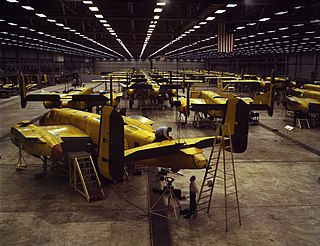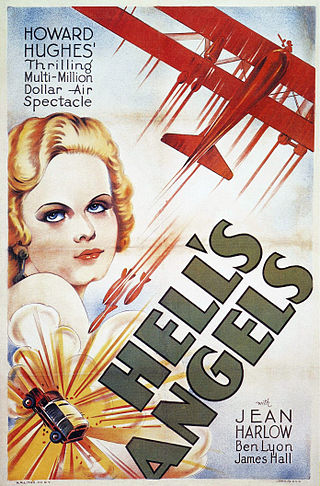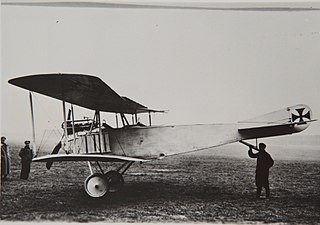Related Research Articles
Vickers-Armstrongs Limited was a British engineering conglomerate formed by the merger of the assets of Vickers Limited and Sir W G Armstrong Whitworth & Company in 1927. The majority of the company was nationalised in the 1960s and 1970s, with the remainder being divested as Vickers plc in 1977.

America's manufacturers in World War II were engaged in the greatest military industrial effort in history. Aircraft companies went from building a handful of planes at a time to building them by the thousands on assembly lines. Aircraft manufacturing went from a distant 41st place among American industries to first place in less than five years.

The Albatros B.II, was an unarmed German two-seat reconnaissance biplane of the First World War.

Hell's Angels is a 1930 American pre-Code independent epic war film directed and produced by Howard Hughes and director of dialogue James Whale. Written by Harry Behn and Howard Estabrook and starring Ben Lyon, James Hall and Jean Harlow, it was released through United Artists. It follows two dissimilar brothers, both members of the British Royal Flying Corps during the First World War.

Kinner Airplane & Motor Corp was an airplane and engine manufacturer, founded, in the mid-1920s, in Glendale, California, United States, by Bert Kinner, the manager of Kinner Field. Kinner's chief engineer was Max B. Harlow who later founded the Harlow Aircraft Company. It went bankrupt in 1937, and the aircraft rights were sold to O.W. Timm Aircraft Company. The engine department was rearranged as Kinner Motor Inc in 1938, but collapsed in 1946. Kinner became the West Coast's largest producer of aircraft engines in 1941.
The Hiro Naval Arsenal at Kure (呉), Hiroshima prefecture, was a production facility for seaplanes, flying boats, and aero engines for the Imperial Japanese Navy before and during World War II. It was largely destroyed in a raid by B-29 Superfortresses on 5 May 1945.
M. B. Arpin & Co. of West Drayton was a British aircraft manufacturer prior to World War II. The firm constructed an unusual aircraft, the A-1 as a new observation type for the British Army, but failed to attract orders.
Automobil und Aviatik AG was a German aircraft manufacturer during World War I. The company was established at Mülhausen in 1909 and soon became one of the country's leading producers of aircraft. It relocated to Freiburg in 1914 and to Leipzig in 1916 and established a subsidiary in Vienna as Österreichisch-Ungarische Flugzeugfabrik Aviatik. During the war, the company became best known for its reconnaissance aircraft, the B.I and B.II, although the Austro-Hungarian subsidiary also produced a number of its own designs, including fighters such as the D.I.

The Bach Aircraft Company was established by aviator L. Morton Bach at Clover Field, Santa Monica, California in 1927 to manufacture tri-motor airliners as the Bach Air Yacht in various models, as well as several other aircraft. The company hired Waldo Waterman as its chief test pilot, who brought on Max B. Harlow as the chief engineer. In 1931, the business was reorganized into the Aircraft Production Corporation but did not manufacture any further new designs.

Cub Aircraft was a Canadian aircraft manufacturer established at Hamilton, Ontario in 1937, originally to manufacture Piper Cubs for the Canadian market. Production was interrupted by World War II, In 1941 they also commenced building Harlow PJC-5s. Although the company resumed business afterwards, it did not survive for more than a few years.

The Harlow PJC-2 was a 1930s American four-seat cabin monoplane, designed by Max Harlow.

The Harlow PC-5 was a 1930s American military trainer version of the PJC-2, and was designed and built by the Harlow Aircraft Company.

Harlow Aircraft Company was an American aircraft manufacturer at Alhambra Airport, Alhambra, California.

Deutsche Flugzeug-Werke, usually known as DFW, was a German aircraft manufacturer of the early twentieth century. It was established by Bernhard Meyer and Erich Thiele at Lindenthal in 1910, and initially produced Farman designs under licence, later moving on to the Etrich Taube and eventually to its own designs. One of these, the DFW C.V reconnaissance aircraft, was produced to the extent of several thousand machines, including licence production by other firms. Plans to develop civil aircraft after the war proved fruitless, and the company was bought by ATG shortly thereafter.

Interstate Aircraft and Engineering Corporation was a small American aircraft manufacturer in production from April 1937 to 1945, based in El Segundo, California.

The Albatros B.III,, was a German World War I reconnaissance biplane, built by Albatros Flugzeugwerke as the Albatros LDD.
Rumpler-Luftfahrzeugbau GmbH, Rumpler-Werke, usually known simply as Rumpler was a German aircraft and automobile manufacturer founded in Berlin by Austrian engineer Edmund Rumpler in 1909 as Rumpler Luftfahrzeugbau. The firm originally manufactured copies of the Etrich Taube monoplane under the Rumpler Taube trademark, but turned to building reconnaissance biplanes of its own design through the course of the First World War, in addition to a smaller number of fighters and bombers.
The Nieuport & General Aircraft Company Ltd was a British aircraft manufacturer, established during the First World War to build French Nieuport aircraft under licence, which closed down in 1920.
Max B. Harlow was an American aircraft engineer, educator, and producer.
References
- ↑ "The Quiet Professor". Air Progress Sport Aircraft: 83.
- Gunston, Bill (1993). World Encyclopedia of Aircraft Manufacturers. Annapolis: Naval Institute Press. p. 31.